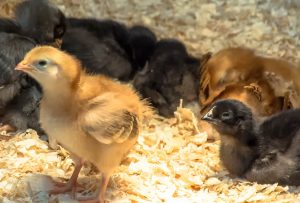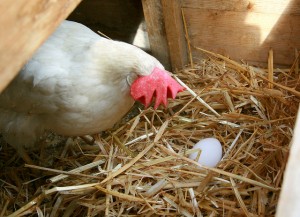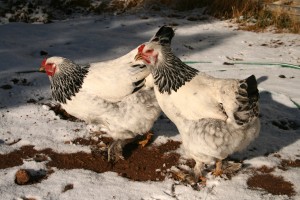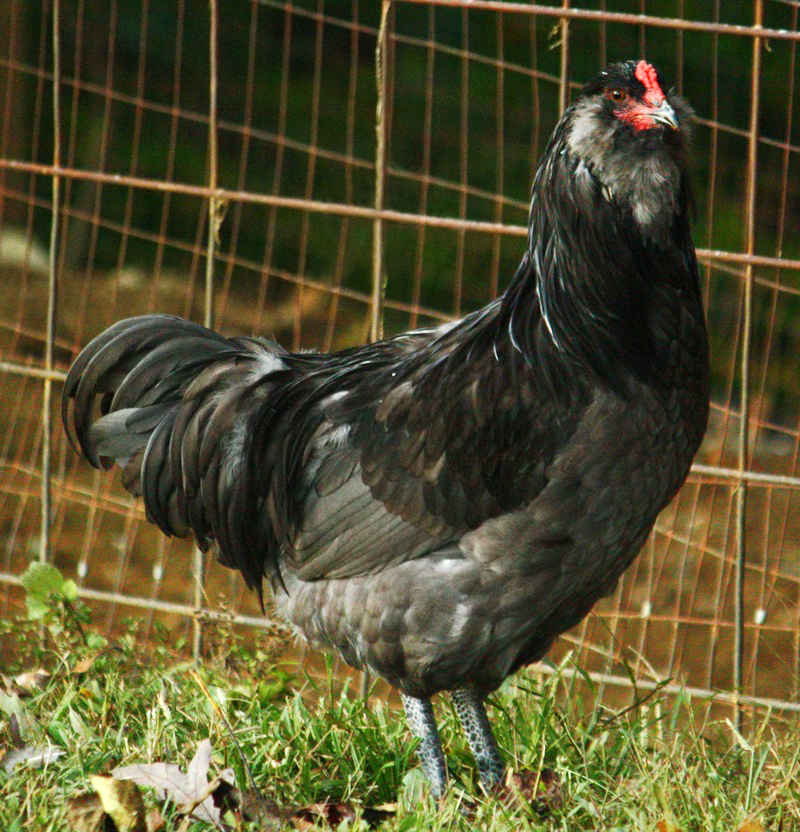In order to raise happy, healthy chicks, you need to make sure that you have the right supplies on hand. Some of the supplies you’ll need are things that you’ll have on hand, some may be supplies that you’ve never needed (if this is your first time with baby chicks). So what exactly do you need for chicks?
Before I can answer this question, there are a few things that you need to keep in mind regarding chicks. Chicks are small and cannot eat large pieces of food. That is why you’ll see chick crumbles in feed stores. Chicks physically cannot swallow large pellets the same way that grown chickens can. Baby chicks need to be kept warm and in a draft-free environment. If the chicks were with their mother, she would keep them warm herself with her body heat. Lastly, chicks need a clean environment with plenty of space to avoid overcrowding and disease.
So let’s talk about what you’ll need to raise your chicks successfully.
Brooder
The first item that should be on your list is a brooder. A brooder is a box that will house your chicks. When picking out a brooder, make sure that it has sides that are tall enough to prevent drafts and to keep the chicks from attempting to jump out. Jumping out won’t be an issue at first, but some chicks can be escape artists and will try to jump out if the sides aren’t tall enough.
When setting up your brooder, make sure that it is in a draft-free area of your home. If you’re putting it outside, it’s a good idea to put it in a shed or barn that will keep predators away from it. You can also put a wire or mesh top on it. Baby chicks are easy prey for raccoons, foxes and other predators, so you’ll want to keep them safe. You can make a brooder from a livestock water trough, a large plastic tote or even a cardboard box in a pinch.
Heat
Inside of the brooder you’ll need a heat source. Remember, your chicks will need heat to keep them warm. Ideally, the bottom of the brooder should be between 95-100°F for the first two weeks of the chicks’ lives. After that, you can start reducing the temperature 5°F per week until they are one month old.
The easiest way to provide them with a heat source is with a heat lamp. You can use a heat lamp and hang it over the brooder. Many of these heat lamps have clips so that you can secure them onto the side of the brooder. Make sure that the lamp is secured and is providing warmth to the chicks.
It’s a good idea to have a thermometer in the brooder so that you can monitor the chicks. I like to put the heat lamp on one side, or in the middle if the brooder is big enough, so that the chicks can move into a slightly cooler area of the brooder if they want to. If the brooder isn’t warm enough, you’ll notice that your chicks are piled together under the heat lamp trying to keep warm. This can lead to trampling of smaller chicks and should be avoided.
Bedding
The chicks will need plenty of clean bedding at the bottom of the brooder. Chicks can be messy, so be prepared to clean it out frequently. The chicks shouldn’t be standing in poop or wet bedding as this can lead to disease and illness. Pine flake shavings are a good option for bedding. Don’t use cedar shavings as the oil in cedar can irritate the skin and lungs of chickens. Chicks will create soiled bedding quickly. You can add a fresh layer of bedding daily for 2-3 days. After this, clean out all of the bedding and start over.
Feeder and Waterer
Chicks that are living in a brooder with bedding on the ground cannot eat feed off of the ground, so you’ll need to invest in a feeder. There are two styles of feeders and both are inexpensive and will save you money on feed by reducing waste. Hanging feeders are a great option because they can be hung up off of the ground. Hang them just high enough that the chicks can access the feed but won’t get shavings or water into the feed.
If you notice that your chicks are trying to climb on the feeder, you may want to play it safe and get a flip top feeder. It’s a good idea to start chicks off with a flip top feeder and then move them up to a hanging feeder when they are a little older. The flip top feeder partially covers the feed while still allowing multiple chicks to access the feed. Keep the feeders full and let chicks eat freely for the best growth results.
You’ll also need to invest in a waterer for your chicks. Just like with feeders, there are a few different styles. The waterers are either made to hang or to set on the ground. I prefer to start them with a waterer that is on the ground and then move them up to a hanging waterer when they get older. Clean the waterers frequently and make sure that the chicks have a steady supply of clean fresh water to drink.
Medication
As long as you take care of your chicks properly, you probably won’t have any health issues. It’s a good idea to already have medications on hand though in case you run into problems. A probiotic and vitamin supplement like Chick Boost can help prevent illness in chicks. You simply add the supplement to the drinking water. You can also buy vitamin packs that provide essential vitamins to ensure proper growth and a good, strong immune system.
Written by: Shelby DeVore
Shelby DeVore is a former high school agriculture teacher that has taught numerous agriculture classes and successfully coached multiple competitive FFA teams, including Tennessee FFA State Poultry teams. She’s an agricultural enthusiast and shares her love of all things farming with her husband and two children on their small farm in West Tennessee. She’s also the author of the blog Farminence, where she enjoys sharing her love of gardening, raising livestock and more simple living.






